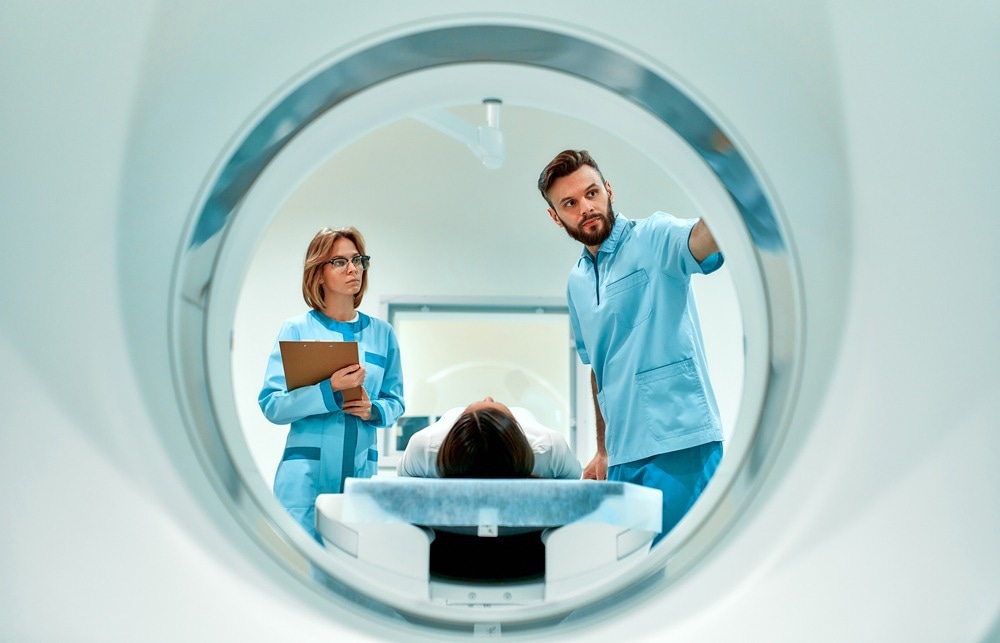In a recent study published in Nature Communications, researchers demonstrated a magnetic resonance imaging (MRI) method sensitive to the live brain's iron homeostasis (the r1-r2 extent of relaxation or relaxivity).
 Study: Non-invasive assessment of normal and impaired iron homeostasis in the brain. Image Credit: ORION PRODUCTION/Shutterstock.com
Study: Non-invasive assessment of normal and impaired iron homeostasis in the brain. Image Credit: ORION PRODUCTION/Shutterstock.com
Background
Iron homeostasis is critical for brain function and is compromised in aging, neurodegenerative disorders, and cancer. Homeostasis of iron in live brain tissue is useful for illness diagnosis, monitoring, treatment, and improving the understanding of disease causation. MRI, due to its paramagnetic characteristics, is a useful and non-invasive approach for assessing iron concentration in tissues of the brain. Understanding iron homeostasis in the brain is critical for accurate illness detection and therapy.
About the study
In the present study, researchers proposed an MRI-based method of iron relaxation in vivo that is sensitive to the homeostasis of iron in the human brain.
The work employed MRI characteristics to analyze molecular iron habitats in the live brain in a non-invasive manner. The researchers used iron's unique relaxivity property on the rates of magnetic resonance relaxation, R1 as well as R2, to build a biophysical framework of the linear interdependence, which was referred to as the r1-r2 relaxivity. The researchers employed the bottom-up approach to assess the relaxivity of various environments of iron in the in vitro settings, followed by the top-down approach to assess the relaxivity in the human brain in the in vivo setting and relate it to the measurement of iron molecules and their genetic expression ex vivo.
The researchers examined the biological underpinnings of relaxivity in healthy individuals and compared them with other magnetic resonance contrasts. The researchers examined the contrast of relaxivity between non-pathological and diseased tissues among meningioma patients and compared the MR imaging results to tumor iron homeostasis calculations in the ex vivo environment. The sensitivity of R1 and R2 to myelin content was studied, and numerical simulations were run to account for the contributions of different brain tissue components to relaxivity assessment.
The researchers investigated the sensitivity of the relaxivity approach to the homeostasis of iron in normal and aged brains. They compiled previously published postmortem histology data characterizing iron, ferritin, and transferrin contents in various brain areas of young and elderly humans and evaluated iron mobilization ability using the postmortem dataset.
The researchers explored how the tumor features acquired by the relaxivity approach differed from the information included in R1 as well as R2. GSEA was used to identify molecular activities that were considerably linked with each MRI value. Finally, the researchers verified the relaxivity method's sensitivity to iron homeostasis at the proteome level by comparing in vivo MRI results to ex vivo iron homeostasis calculation on the same tissue.
Results
In the in vitro environment, the MRI method was utilized to investigate the unique paramagnetic characteristics of ferrous, transferring, and ferritin ions. The technique was confirmed in the human brain in vivo versus ex vivo iron compound measurement and gene expression. The relaxivity method indicated iron homeostasis in tumors and distinguished neoplastic tissues from healthy tissues. The relaxivity model offered in vivo iron relaxivity data to aid in the identification of various iron environments in the brain.
Both R1 as well as R2 rose when the concentration of various iron compounds increased, with the rate of this rise, termed the iron relaxivity, varying depending on the iron environment. The iron relaxivity, which separated the iron environments and was consistent whether computed over samples with greater or lower amounts, might clarify the issue at hand.
The relaxivity was a decent MRI estimate for the ratio of R1: R2 iron relaxivities. Compared to iron-bound transferrin, apo-transferrin showed a considerably lower r1-r2 relaxivity, which contains paramagnetic characteristics that induce the relaxivity. The study findings indicated that the relaxivity method might be utilized to evaluate the extent of MR relaxation for iron in vivo to expose the differential paramagnetic characteristics of various molecular iron environments.
The results also revealed that the relaxivity of r1 and r2 was less susceptible to lipid content and composition than R1 as well as R2. In the human brains investigated in vivo, the relaxivity of r1 and r2 exhibited a statistically distinct MRI difference between R1 and R2. The R1 and R2 values demonstrated a considerable separation between gray-matter and white-matter areas, but the contrast observed by the relaxivity method across the brain exhibited a unique spatial pattern and highlighted distinctions across brain regions beyond the conventional white-matter-gray matter divergence.
The r1-r2 relaxivity was connected to iron mobilization ability across the brain and in aging. R2 was highly linked with iron levels, indicating that the in vivo and postmortem datasets agreed. Iron mobilization ability was considerably linked with the relaxivity of r1 and r2 across brain areas and age groups, but not with R2 or R1. The relaxivity approach improved the differentiation between tumor and non-pathological tissue, with the impact of gadolinium (Gd)-free contrast equivalent in magnitude to that of Gd-based contrast. The findings provided support for the sensitivity of the relaxivity approach to iron homeostasis at the gene expression level.
The two most enriched pathways for r1-r2 relaxivity were "immunoglobulin complex" and "scavenging of heme from plasma." The relaxivity indicated variations in iron homeostasis amongst tumor tissues, with relaxivity being considerably greater for tumors with a high transferrin/ferritin ratio compared to tumors with a low transferrin/ferritin ratio. The relaxivity evaluated in vivo revealed pathological disturbances in iron homeostasis that were previously only observed ex vivo, according to gene expression and proteomics investigations.
Conclusion
Overall, the study findings showed that the method may enable non-invasive investigation and diagnosis of iron homeostasis in living human brains.